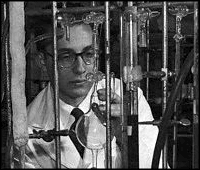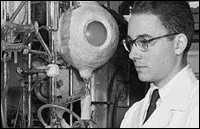A Repeat of the first Origin of Life Experiment
 |
Chemist
Jeffrey Bada, of the Scripps Institute
of Oceanography
in La Jolla, Calif. is revisiting the famous
experiment first done by his mentor, Stanley
Miller. "Maybe we're over-optimistic, but I
think this is a paradigm shift," in Origins of
Life research says Bada. After their famous
experiment the Miller-Urey results were later
questioned: It turns out
that the gases
he used, a reactive mixture of methane and ammonia, may
not have existed in large amounts on early Earth. Scientists now believe the
primeval atmosphere contained a greater inert mix
of carbon dioxide and nitrogen—a change that made a world of
difference. ↓ |
|
When Miller himself, repeated the experiment using the correct combo in 1983, the brown broth failed to materialize. Instead, the mix created a colorless brew, containing few amino acids. It seemed to refute a long-cherished icon of evolution—and creationists quickly seized on it as supposed evidence of evolution's wobbly foundations. However, Bada's repeat of the experiment—armed with a new insight—seems likely to turn the tables once again. Bada discovered that the reactions were producing chemicals called nitrites, which destroy amino acids as quickly as they form. They were also turning the water acidic—which prevents amino acids from forming. Yet primitive Earth would have contained iron and carbonate minerals that neutralized nitrites and acids. So Bada added these chemicals to the experiment to duplicate these functions. When he reran the experiment, he still got the same watery liquid as Miller did in 1958, but this time it was chuck-full of amino acids. Bada presented his results the last week of March, 2007 at the American Chemical Society annual meeting in Chicago. Christopher McKay, a planetary scientist at NASA Ames Research Center in Moffett Field, California said the repeat experiment is important for it's a move toward more realism in terms of what the conditions actually were on early Earth. Many Origin of Life researchers believe that the origin of life depended heavily on chemicals delivered to Earth in Panspermic-like events by comets and meteorites. The repeat of Miller's experiments if viable could shift the paradigm back said Christopher Chyba, an astrobiologist at Princeton University. "That would be a terrific result for understanding the origin of life," he says, "and for understanding the prospects for life elsewhere." Bada's experiment could also have
implications for life on Mars, because the Red
Planet may have been swaddled in nitrogen and
carbon dioxide early in its life. Bada intends to
test this extrapolation by doing experiments with
lower-pressure mixes of those gases. |
